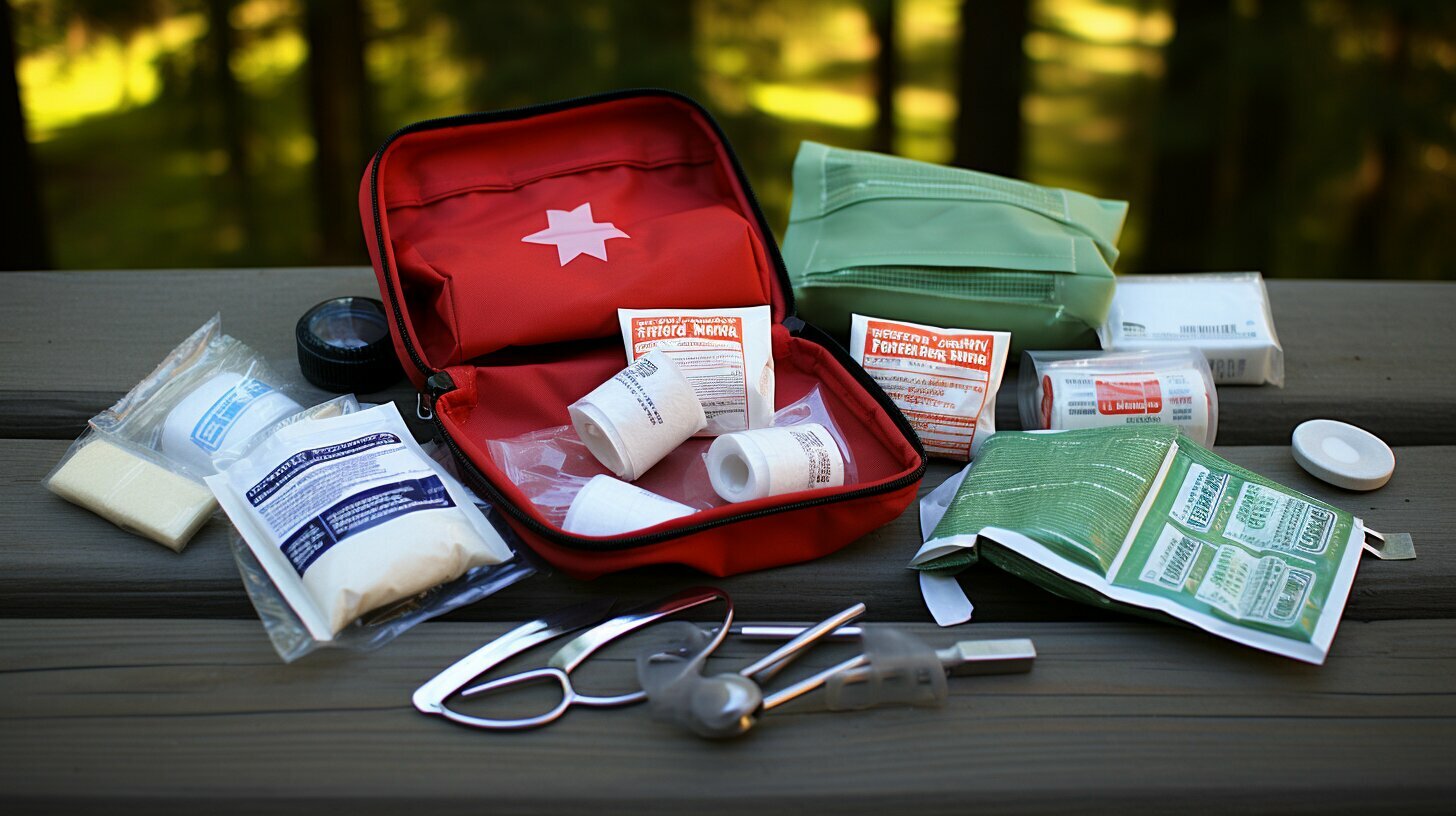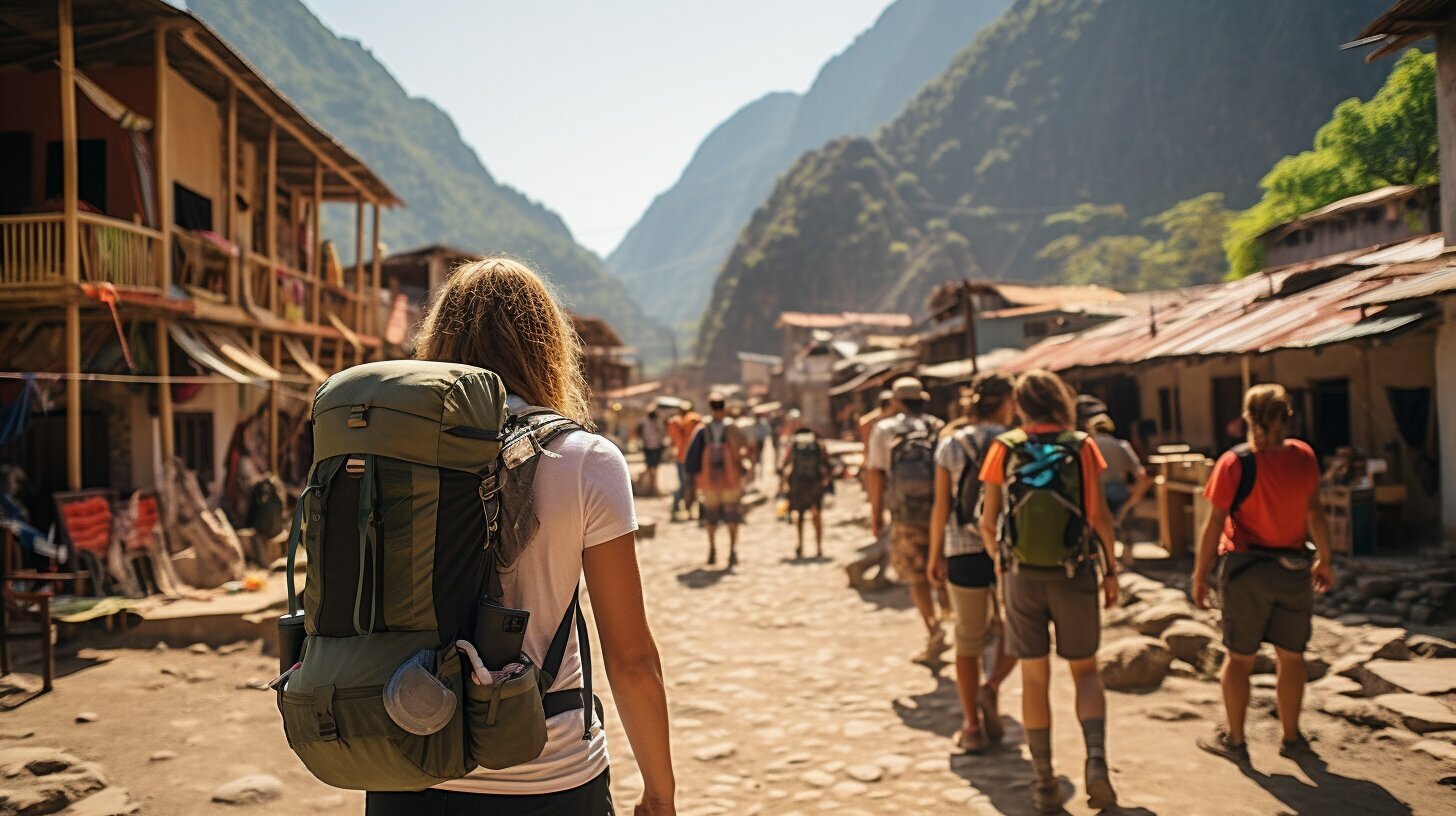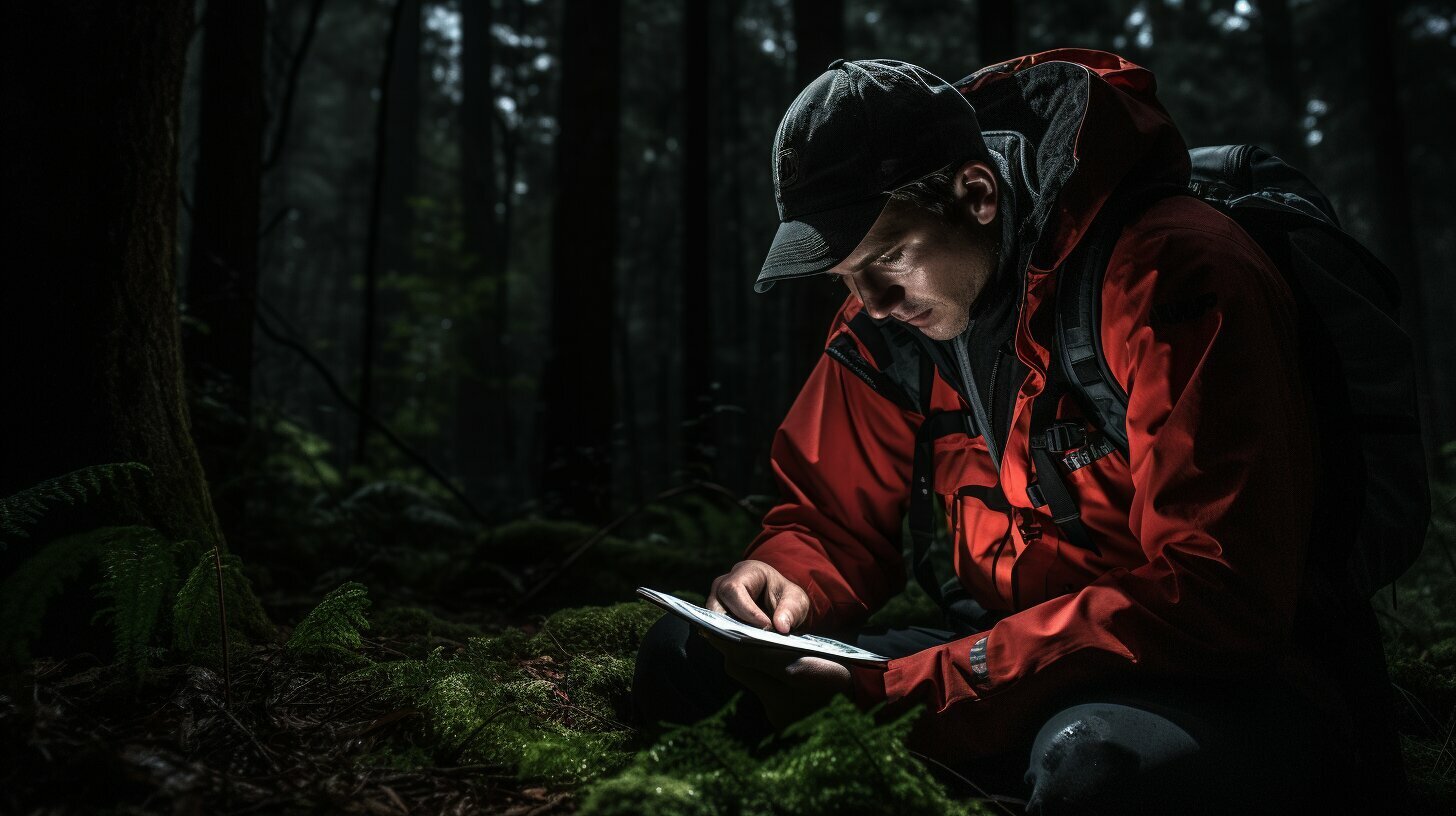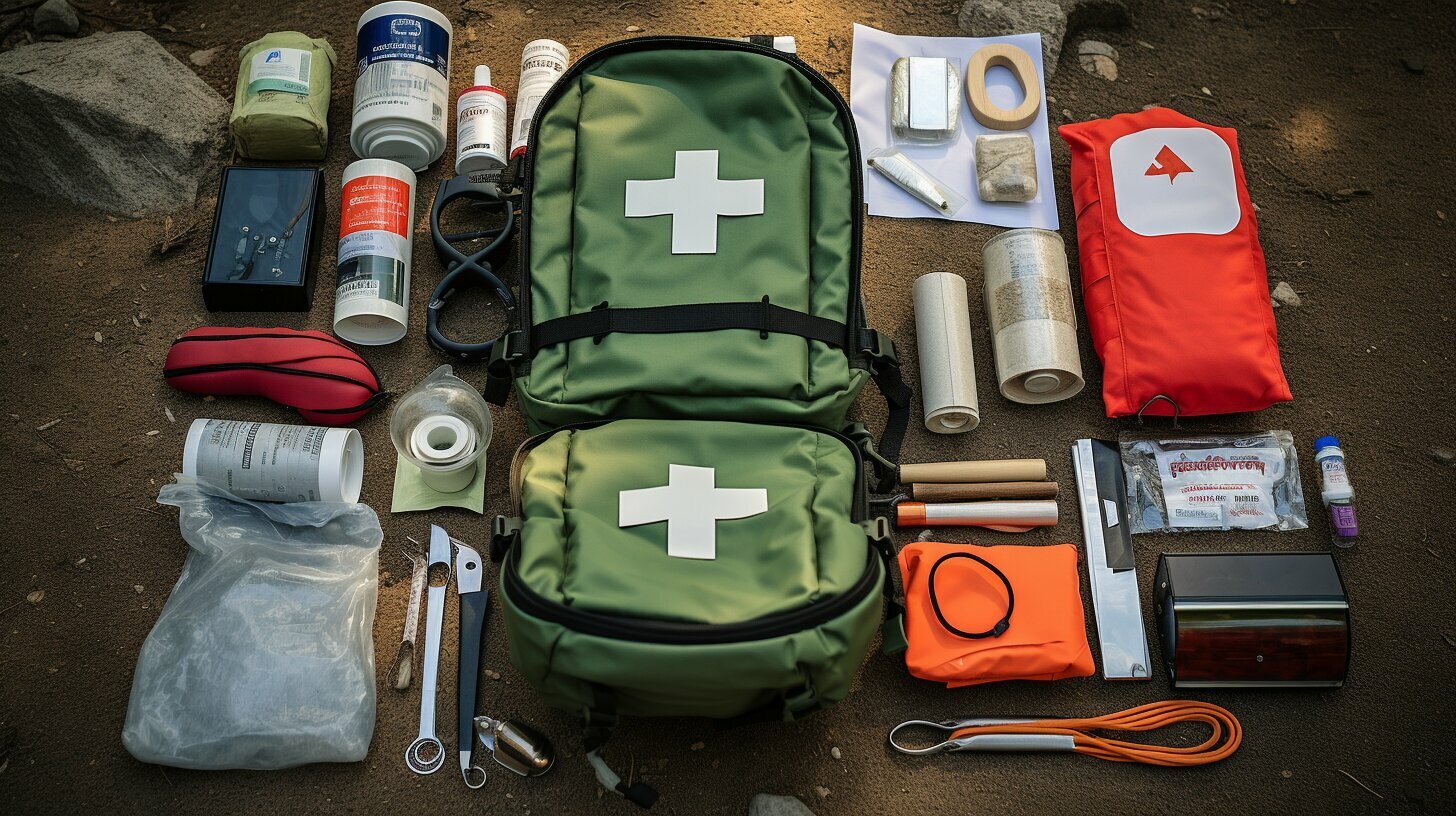When preparing for backpacking adventures, it is crucial to pack a well-equipped first aid kit that includes essential items to ensure your safety and well-being. Striking the right balance between carrying necessary items and avoiding unnecessary bulk is key.
Some of the essential items to consider including in your backpacker first aid kit are medical tape, nitrile medical gloves, antiseptic wipes, butterfly closure strips, dressing/gauze for larger wounds, triple antibiotic ointment, hand sanitizer, ibuprofen tablets, antihistamine tablets, duct tape, a small utility tool, a sewing needle, safety pins, a tiny whistle, an emergency fire starter, and a small business-size card with emergency contact information. These items will help you handle minor injuries and emergencies during your backpacking journey.
For backpacking in developing countries, additional considerations should be made. It is recommended to bring necessary medications from home and conduct thorough research on health-related information about the destination beforehand. Understanding potential health risks and preparing accordingly will help you stay safe during your trip.
Furthermore, it is crucial to invest in training by taking a first-aid course and having reference books on wilderness medicine. Being knowledgeable in basic first aid techniques and having access to reliable resources can make a significant difference in emergency situations.
Ultralight backpackers, who prioritize minimizing weight and bulk, should tailor their first aid kit to their specific needs. Adhesive bandages, medical tape, antibiotic treatment, small packages of pills, antiseptic wipes, butterfly bandages, tweezers, safety pins, moleskin, water treatment tablets, latex gloves, a multi-tool, sunscreen, lip balm, bug spray, and feminine hygiene products are some of the essential items for ultralight backpackers to consider.
Lastly, when preparing your travel first aid kit, take into account your individual needs and the specific travel destination or activity. Consider any personal medical conditions, the duration of your trip, and the type of outdoor activities you plan to engage in. Tailoring your first aid kit will ensure that you are well-prepared for any potential emergencies.
Remember, packing a well-stocked first aid kit is essential for your safety during backpacking adventures. By being prepared and carrying the necessary supplies, you can enjoy your outdoor activities with peace of mind.
What to Include in a Backpacker’s First Aid Kit
A well-prepared backpacker’s first aid kit should contain a range of essential items to handle various medical emergencies that may arise during outdoor adventures. When packing your kit, it is crucial to strike a balance between carrying the necessary items and avoiding unnecessary bulk. Here are some key items to consider including:
Medical Supplies
- Medical tape
- Nitrile medical gloves
- Antiseptic wipes
- Butterfly closure strips
- Dressing/gauze for larger wounds
- Triple antibiotic ointment
Medications and Tools
- Hand sanitizer
- Ibuprofen tablets
- Antihistamine tablets
- Duct tape
- A small utility tool
- A sewing needle
- Safety pins
- A tiny whistle
- An emergency fire starter
- A small business-size card with emergency contact information
These items will help you address common injuries and ailments while on the trail. However, it’s important to note that the contents of your first aid kit may vary depending on your specific needs and the nature of your trip. For instance, if you are backpacking in developing countries, it is recommended to bring necessary medications from home and conduct thorough research on health-related information about the destination beforehand.
If you plan to engage in ultralight backpacking, where minimizing weight and bulk is a priority, you may want to consider a pared-down first aid kit. In addition to the above items, you could include adhesive bandages, medical tape, antibiotic treatment, small packages of pills, antiseptic wipes, butterfly bandages, tweezers, safety pins, moleskin, water treatment tablets, latex gloves, a multi-tool, sunscreen, lip balm, bug spray, and feminine hygiene products.
Remember, it’s important to tailor your travel first aid kit to your individual needs and the specific travel destination or activity. By carrying a well-equipped first aid kit, you can be better prepared to handle any medical emergencies that may arise during your backpacking adventures.

Considerations for Backpacking in Developing Countries
Backpacking in developing countries requires additional preparation, including ensuring you have necessary medications and understanding the health risks associated with the destination. It is essential to take proactive steps to protect your health and well-being during your trip. Here are some key considerations to keep in mind when preparing your first aid kit for backpacking in developing countries:
Research Health Risks
Before embarking on your journey, thoroughly research the health risks specific to your destination. Find out if there are any prevalent diseases or conditions you need to be aware of, such as malaria, dengue fever, or gastrointestinal illnesses. Consult reliable sources such as travel health websites or consult with a healthcare professional who specializes in travel medicine. This information will help you understand what preventive measures to take and what medications to include in your first aid kit.
Pack Necessary Medications
It is crucial to bring any necessary medications from home to ensure you have an adequate supply during your trip. This includes prescription medications, over-the-counter medications for common ailments like allergies or diarrhea, and any specific medications you may need for pre-existing medical conditions. Make sure to carry these medications in their original packaging and keep them easily accessible in your first aid kit.
When backpacking in developing countries, it’s important to consider the local health infrastructure and the availability of medical facilities. Research the nearest hospitals or clinics in the areas you plan to visit and understand their capabilities. This information will help you determine what additional items you may need to include in your first aid kit, such as sterile needles or syringes, in case you need to receive medical treatment while traveling.
| Items to Consider for Your Backpacker’s First Aid Kit |
|---|
| Prescription medications |
| Over-the-counter medications (pain relievers, anti-diarrheal, antihistamines) |
| Antibiotics for common infections |
| Oral rehydration salts |
| Insect repellent |
| Sunscreen with high SPF |
| Water purification tablets |
| Adhesive bandages and dressings |
| Tweezers and scissors |
| Antiseptic wipes and hand sanitizer |
Remember that every backpacker’s first aid kit should be customized to their individual needs and the specific travel destination. Consider factors such as the duration of your trip, the activities you plan to engage in, and any personal medical conditions. Regularly check the expiration dates of medications and replace any items that have expired. By taking these precautions and being adequately prepared, you can enjoy your backpacking adventure while prioritizing your health and well-being.

Prioritising your safety as a backpacker involves acquiring the necessary skills through a first-aid course and keeping informative reference books on wilderness medicine handy. These resources are invaluable in providing you with the knowledge and confidence to handle medical emergencies that may arise during your outdoor adventures.
By undertaking a first-aid course, you will learn essential techniques for treating wounds, injuries, and illnesses in remote settings. This training will equip you with the skills needed to administer effective first aid until professional medical help is available. Additionally, it will teach you how to assess situations, make quick decisions, and provide the best care possible in challenging environments.
Reference books on wilderness medicine serve as valuable companions, providing you with detailed information on various medical conditions, their symptoms, and appropriate treatment options when far from conventional healthcare facilities. These books offer guidance on managing injuries specific to outdoor activities and can help you make informed decisions in critical situations.
Recommended First-Aid Course Providers:
| Provider | Website | Contact |
|---|---|---|
| Wilderness Medical Associates International | www.wildmed.com | 123-456-7890 |
| Red Cross | www.redcross.org | 987-654-3210 |
| St. John Ambulance | www.sja.org.uk | 555-123-4567 |
Remember, preparation is key when venturing into the great outdoors. By undergoing a first-aid course and having reference books on hand, you are taking proactive steps to ensure the safety and well-being of yourself and your fellow backpackers.

Ultralight backpackers have unique requirements when it comes to first aid kits, necessitating a compact selection of essential items that prioritize weight and space efficiency. When every ounce counts, it’s crucial to carefully consider what to include in your kit to ensure you’re prepared for emergencies without adding unnecessary bulk to your pack.
Here’s a list of some essential items that ultralight backpackers should consider packing:
- Adhesive bandages: These come in various sizes and are useful for covering minor cuts and scrapes.
- Medical tape: Secure dressings and bandages in place with lightweight medical tape.
- Antibiotic treatment: Carry a small supply of antibiotics to help prevent infection in case of any open wounds.
- Water treatment tablets: Ultralight backpackers rely on lightweight solutions, and water treatment tablets are an effective way to purify water and prevent waterborne illnesses.
Additionally, it’s important to consider other items such as antiseptic wipes, butterfly bandages, tweezers, safety pins, moleskin for blisters, latex gloves, a multi-tool, sunscreen, lip balm, bug spray, and feminine hygiene products. These items can help address common injuries and discomforts encountered during backpacking trips.
Remember, each backpacker’s needs may vary, so it’s essential to tailor your first aid kit to your individual requirements and the specific demands of your travel destination or activity. By carefully selecting lightweight and multi-functional items, you can ensure you have the necessary supplies to handle minor injuries and illnesses while keeping your pack light and efficient.

Here’s a summarized table of the essential items for an ultralight backpacker’s first aid kit:
| Item | Description |
|---|---|
| Adhesive bandages | Various sizes for covering cuts and scrapes. |
| Medical tape | Secure dressings and bandages. |
| Antibiotic treatment | To prevent infection in open wounds. |
| Water treatment tablets | Lightweight solution for purifying water. |
| Antiseptic wipes | Cleanse wounds and prevent infection. |
| Butterfly bandages | Close and protect larger wounds. |
| Tweezers | Remove splinters or ticks. |
| Safety pins | Secure bandages or gear. |
| Moleskin | Relief for blisters. |
| Latex gloves | Protection during wound care. |
| Multi-tool | Versatile tool for various tasks. |
| Sunscreen | Protection from harmful UV rays. |
| Lip balm | Prevent chapped lips. |
| Bug spray | Keep insects at bay. |
| Feminine hygiene products | Address menstrual needs. |
With these essentials in your ultralight backpacking first aid kit, you’ll be prepared to handle common injuries and ailments while keeping your load light and efficient. Remember to always prioritize weight and space efficiency when selecting items for your kit, and tailor it to your specific needs and travel plans.
Tailoring Your Travel First Aid Kit to Your Needs
To ensure your travel first aid kit is comprehensive and suited to your individual needs, it is essential to take into account your medical conditions, the duration of your trip, and the outdoor activities you will be participating in. By considering these factors, you can ensure that you have the necessary supplies to address any potential health concerns or emergencies that may arise during your travels.
A good starting point is to review your medical conditions and any prescription medications you may require. Make sure to pack an adequate supply of your medications, along with any necessary documentation or prescriptions. It is also wise to include basic over-the-counter remedies such as pain relievers, antihistamines, and stomach medications.
Next, consider the duration of your trip. If you will be traveling for an extended period, you may need to pack a larger quantity of certain items, such as bandages or medications. On the other hand, if you will only be away for a short time, you may be able to bring smaller, travel-sized versions of certain items.

Finally, think about the activities you will be engaging in during your trip. For example, if you plan to go hiking or participate in water sports, you may need to include items such as blister pads, water purification tablets, or waterproof bandages. If you will be spending time in areas with high insect activity, insect repellent and sting relief products may be necessary.
By carefully considering your medical needs, trip duration, and planned activities, you can tailor your travel first aid kit to meet your specific requirements. This will ensure that you are prepared for any potential health issues that may arise, allowing you to enjoy your travels with peace of mind.
Conclusion: Be Prepared and Stay Safe
As a backpacker, it is essential to prioritize your safety and well-being by packing a well-equipped first aid kit that includes the necessary supplies for any potential medical emergencies you might encounter during your adventures. When packing your first aid kit, it’s important to strike a balance between carrying essential items and avoiding unnecessary bulk.
Some of the key items to consider including in your backpacking first aid kit are medical tape, nitrile medical gloves, antiseptic wipes, butterfly closure strips, dressing/gauze for larger wounds, triple antibiotic ointment, hand sanitizer, ibuprofen tablets, antihistamine tablets, duct tape, a small utility tool, a sewing needle, safety pins, a tiny whistle, an emergency fire starter, and a small business-size card with emergency contact information.
If you’re planning to hike in developing countries, it is highly recommended to bring necessary medications from home and conduct thorough research on health-related information about your destination beforehand. Additionally, taking a first-aid course and having reference books on wilderness medicine can provide you with valuable knowledge and guidance in emergency situations.
For ultralight backpackers, who prioritize minimizing weight and bulk, a pared-down first aid kit might include adhesive bandages, medical tape, antibiotic treatment, small packages of pills, antiseptic wipes, butterfly bandages, tweezers, safety pins, moleskin, water treatment tablets, latex gloves, a multi-tool, sunscreen, lip balm, bug spray, and feminine hygiene products.
Lastly, it is crucial to pack a travel first aid kit that is tailored to your individual needs and the specific travel destination or activity. Consider any personal medical conditions, the duration of your trip, and the type of outdoor activities you plan to engage in when selecting items for your first aid kit.
By being prepared and carrying a well-stocked first aid kit, you can ensure that you are ready to handle any medical situation that may arise during your backpacking adventures. Prioritize your safety and enjoy your outdoor experiences with peace of mind.
